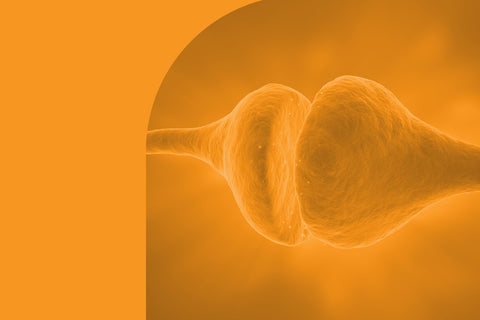
Want to get high (and so much more) on your own supply? Welcome to your amazing endocannabinoid system (ECS).
The ECS is a biological system composed of endocannabinoids (cannabis-like cannabinoids manufactured by the body), neurotransmitters, cannabinoid receptors, and receptor proteins. The ECS serves a major role in regulating and balancing many processes in the body, including the immune response, communication between cells, appetite, metabolism, memory, hormonal response, your dance moves (just kidding), and much more.
In the early 2000’s, the term Clinical Endocannabinoid Deficiency Syndrome (CED) was coined to describe symptoms and conditions that may arise due to depressed ECS activity or tone.
Read on to find out more about the importance of the ECS, CED, and what you can do to improve your ECS tone! Hint, you can smoke it but we prefer the buccal troche. :)
The History of the ECS
Cannabis has been used medicinally since 2000 BC. A mythical emperor named Shen Nong, aka The Divine Farmer, is attributed to its discovery. The topical use of cannabis for inflammation is mentioned in the Egyptian Ebers paper dated back to 1500 BC.
The two primary components of the cannabis plant are cannabidiol (CBD) and tetrahydrocannabinol (THC) although many minor cannabinoids exist and are still being discovered today. CBD was first isolated in 1940. However, since CBD was non-psychoactive, it was neglected in favor of THC. In 1964, Mechaoulam and Gaoni determined the structure of THC. Mechaoulam identified THC as psychoactive by testing its effects on monkeys [1].
In 1988, Devane and other researchers characterized the first cannabinoid receptor (CB1R) in rat and human brains [1]. Later, Devane isolated the first endocannabinoid, arachidonoylethanolamide (AEA), otherwise known as anandamide. AEA is found in nearly all tissues in a wide variety of animals. It is known as your “bliss” chemical because it improves your sense of well-being and, well, bliss! AEA, along with other endocannabinoids, bind to the resident cannabinoid receptor.
Today, it is understood that the ECS is composed of endocannabinoids such as AEA and 2-arachidonoylglycerol (2-AG), and the two primary cannabinoid receptors (CB1R and CB2R).
The Function of the ECS
The effects of endocannabinoids are mediated by CB1R and CB2R. CB1R are located in the central nervous system (CNS). CB2R are expressed in much lower levels in the CNS, however, they are found in abundance in microglia and vascular elements. Both of these receptors are G-protein coupled receptors (GPCR’s) [2]. This means that their activation inhibits adenylyl cyclases and voltage-dependent calcium channels, while activating MAP kinases [2]. In other words, these receptors have diverse effects on cellular physiology and function.
AEA and 2-AG are examples of endocannabinoids that bind to these receptors. 2-AG has diverse functions outside the ECS as well. For instance, 2-AG in the brain, lung, and liver is the major source of arachidonic acid used for prostaglandin synthesis [2].
When CB1R is bound, it modulates neurotransmission by inhibiting GABA and glutamate release from presynaptic terminals [3]. This is proposed to be the underlying cause behind CB1R-mediated neuroprotection against excitotoxicity, which causes epilepsy and may contribute to neurodegenerative diseases [3].
The ECS is also known for its ability to regulate pain. One of the earliest applications of cannabis was pain relief. Cannabinoids such as THC and CBD bind to the CB1 receptor to help reduce pain, inflammation, and hyperalgesia [4]. The CB2 receptor has also been shown to display anti-nociceptive (anti-pain) effects in animal models of pain [5].
The anti-inflammatory effects of THC and CBD are also extensive. THC is known to inhibit PGE-2 synthesis, decrease platelet aggregation, and stimulate lipoxygenase [4].
THC is twenty times more potent than aspirin and two times more potent than hydrocortisone when it comes to decreasing inflammation [4].
Cannabinoids have also been used in cancer management. They have been used to alleviate nausea and vomiting. They may also have anti-tumor effects due to their inhibition of cell proliferation and induction of apoptosis [3].
What is CED?
CED was first proposed in 2001 in two publications. In 2004, it was further explored in another publication. “The theory of CED was based on the concept that many brain disorders are associated with neurotransmitter deficiencies, affecting acetylcholine in Alzheimer's disease, dopamine in parkinsonian syndromes, serotonin and norepinephrine in depression, and that a comparable deficiency in endocannabinoid levels might be manifested similarly in certain disorders that display predictable clinical features as sequelae of this deficiency [6]."
Each of us has an endocannabinoid tone which reflects our levels of endocannabinoids and the abundance of ECS receptors in our brain. This is likely dictated by a combination of genetic and environmental factors.
If the level of endocannabinoids or their receptors are depressed, the physiological systems associated with the ECS tone may also be negatively impacted.
The strongest case for the existence of CED is present in migraines, fibromyalgia, and Irritable Bowel Syndrome (IBS). This is due to conditions that all three share:
- All manifest hyperalgesic states (very sensitive to pain) that must be clinically diagnosed based on subjective criteria as all lack characteristic tissue pathology or easily accessible objective laboratory findings [6].
- All are diagnoses of exclusion that often generate extensive negative diagnostic work-ups [6].
- They display elevated incidence of anxiety and depression.
- They have been labeled psychosomatic in origin or worse, a wastebasket diagnosis, at one time or another by skeptical clinicians [6].
Other disorders which may be impacted by poor ECS tone include disorders of mood, sleep, pain, PTSD, cystic fibrosis, bipolar disease, glaucoma, and many others.
Improve ECS tone, Improve IBS
The common drugs we currently give to IBS patients are poorly tolerated and don’t often work well. These include anticholinergics, anti-spasmodics, medications for gas, and even antidepressants.
In general, the roles of the ECS in the gut are to control intestinal hyper-contractility, modulate intestinal inflammation, and regulate gut-brain communications. These are all functions that may be abnormal in IBS.
More specifically, in the gut lining, there are several endocannabinoids + CB1 and CB2 receptors. All are involved in maintaining the health of the gut lining. Activation of CB1R attenuates large and small bowel muscle tone and inhibits gastrointestinal (GI) motility [7]. CB2R is expressed in intestinal immune cells and its activation decreases inflammation [7]. AEA regulates appetite and energy balance, while 2-AG serves as a hunger signal and plays a vital role in maintaining immunological health in the gut [7].
Many IBS patients exhibit distinct variations of the ECS tone. For example, IBS-D patients have lower levels of PEA and OEA (endocannabinoids) compared to healthy individuals, while IBS-C patients show higher levels than normal [7]. Clinical trials have revealed that lower PEA levels are associated with cramps in the abdominal region, and treatment utilizing PEA may help with pain management [7].
Tip o’ the Iceberg + Troscriptions
There is also evidence that cannabis (and thus cannabinoids) may be a safe and effective treatment for fibromyalgia [8], chronic nerve pain [9], migraines [10], and many more conditions. We are truly at the tip of the iceberg in understanding the many benefits of improving ECS tone by using exogenous cannabinoids.
At Troscriptions, we use cannabinoids in our formulations to directly augment ECS tone. In Blue Canantine, CBD was added to the formula to decrease the degradation of AEA, our bliss hormone, because more focus and more productivity alongside more bliss is a most awesome experience, wouldn’t you agree? Plus AEA decreases inflammation and is neuroprotective as well.
We use CBD + CBG in Tro Calm, our buccal troche for stress/tension relief. While nicotinoyl-GABA and kava in the formula work on GABA receptors or GABA release, these two cannabinoids work together to improve ECS tone for more bliss, decreased response to pain, less inflammation, and much more.
CED is a real syndrome and mounting evidence is showing that improving ECS tone can help. So why wait? Give your ECS a little love with some cannabinoids that may help now!
References
- Crocq M. A. (2020). History of cannabis and the endocannabinoid system . Dialogues in clinical neuroscience, 22(3), 223–228. https://doi.org/10.31887/DCNS.2020.22.3/mcrocq
- Lu, H. C., & Mackie, K. (2016). An Introduction to the Endogenous Cannabinoid System. Biological psychiatry, 79(7), 516–525. https://doi.org/10.1016/j.biopsych.2015.07.028
- Zou, S., & Kumar, U. (2018). Cannabinoid Receptors and the Endocannabinoid System: Signaling and Function in the Central Nervous System. International journal of molecular sciences, 19(3), 833. https://doi.org/10.3390/ijms19030833
- Russo E. B. (2008). Cannabinoids in the management of difficult to treat pain. Therapeutics and clinical risk management, 4(1), 245–259. https://doi.org/10.2147/tcrm.s1928
- Jhaveri, M. D., Sagar, D. R., Elmes, S. J., Kendall, D. A., & Chapman, V. (2007). Cannabinoid CB2 receptor-mediated anti-nociception in models of acute and chronic pain. Molecular neurobiology, 36(1), 26–35. https://doi.org/10.1007/s12035-007-8007-7
- Russo E. B. (2016). Clinical Endocannabinoid Deficiency Reconsidered: Current Research Supports the Theory in Migraine, Fibromyalgia, Irritable Bowel, and Other Treatment-Resistant Syndromes. Cannabis and cannabinoid research, 1(1), 154–165. https://doi.org/10.1089/can.2016.0009
- Brugnatelli, V., Turco, F., Freo, U., & Zanette, G. (2020). Irritable Bowel Syndrome: Manipulating the Endocannabinoid System as First-Line Treatment. Frontiers in neuroscience, 14, 371. https://doi.org/10.3389/fnins.2020.00371
- Sagy, I., Bar-Lev Schleider, L., Abu-Shakra, M., & Novack, V. (2019). Safety and Efficacy of Medical Cannabis in Fibromyalgia. Journal of clinical medicine, 8(6), 807. https://doi.org/10.3390/jcm8060807
- Wilsey, B., Marcotte, T., Deutsch, R., Gouaux, B., Sakai, S., & Donaghe, H. (2013). Low-dose vaporized cannabis significantly improves neuropathic pain. The journal of pain, 14(2), 136–148. https://doi.org/10.1016/j.jpain.2012.10.009
- Rhyne, D. N., Anderson, S. L., Gedde, M., & Borgelt, L. M. (2016). Effects of Medical Marijuana on Migraine Headache Frequency in an Adult Population. Pharmacotherapy, 36(5), 505–510. https://doi.org/10.1002/phar.1673





Comments (0)
There are no comments for this article. Be the first one to leave a message!